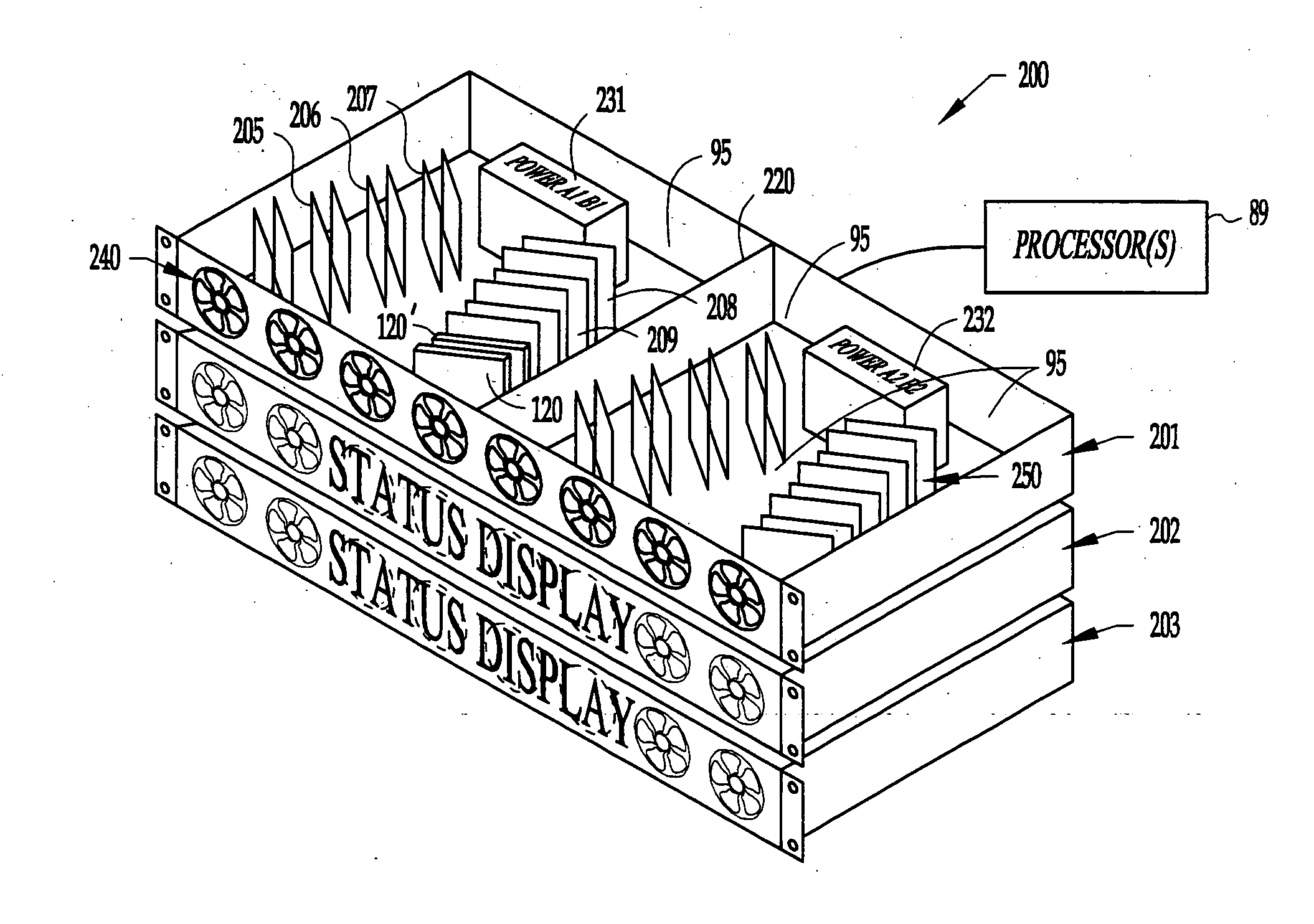System and method for reduced vibration interaction in a multiple-disk-drive enclosure
a technology of vibration interaction and multiple drives, applied in the field of computer data storage, can solve the problems of large amount of digital storage, huge bandwidth, cost prohibitive, etc., and achieve the effects of reducing detrimental results, increasing the incidence of reads, and reducing read and write errors
- Summary
- Abstract
- Description
- Claims
- Application Information
AI Technical Summary
Benefits of technology
Problems solved by technology
Method used
Image
Examples
embodiment a1
[0142] Counter-Rotating Disk Drives in a Mirrored Set to Offset Rotational Acceleration Vibration (RAV)
[0143]“Mirrored disks” are a set of M (where M is two or greater) disk drives that are logically connected as a set and at least some of the data written to that logical set is replicated to each of the M drives for each write operation. In some embodiments, all data sent to the set of drives is replicated, while in other embodiments, some amount (e.g., one hundred fifty GB) or some percentage of the drive's data space (e.g., fifty percent) is mirrored and the remaining data on each drive is unique or different, in order to provide mirrored speed and redundancy for the portion that is replicated, while also providing a lower cost per gigabyte for the other data by writing only a single copy. The processor elements (PEs) or operating system (OS), in some embodiments, could see a set of four three-hundred-GB drives as one four-way-mirrored drive of one hundred fifty GB, plus four non...
embodiment a2
[0144] Counter-Rotating Disk Drives in a Mirrored Set to at Least Partially Offset RAV, Optionally Also Using Read Splitting
[0145] Again, every write operation is sent to all M drives, so every drive has a copy of all the data. In some embodiments, each read operation is sent to only one of the M drives, so the other drives have less utilization and can accept read operations to retrieve other data. This provides the increased reliability of the duplicated data, and increases read performance since more drives can be performing separate read operations simultaneously. Again, the drives are placed alternately back-to-back or front-to-front, as shown in FIG. 4A, so that half of the drives are rotating in the opposite direction as the other half. Since all write seek operations (only for writes) are sent to all M drives of the set, the rotational accelerations of the write-seek operations cancel, at least to some extent. Further, to the extent that probability allows, the read-seek ope...
embodiment b
[0159] Orthogonal Placement of Disk Drives as Rotational-Force Mass Dampers
[0160] When data is read from or written to a plurality of mechanically coupled disk drives, each seek operation issued to any disk produces a corresponding rotational force in the head-disk assembly (HDA) mechanism, the energy of which is transmitted to surrounding structures which either absorb or transmit that energy. When a subject disk absorbs an RAV component produced by another nearby disk about the ZR axis of the subject disk, the negative effects of RAV are maximized. By positioning a plurality of disk drives orthogonally to each other, the RAV energy created by one drive may be transmitted to and absorbed by the mass of nearby orthogonally oriented drives without acting on the subject drives around their ZR axis, which is the axis of greatest sensitivity.
[0161]FIG. 4B shows a pair of drives in a T orientation. Neighboring disk drive 160 is at a right angle (at or about ninety degrees) to reference ...
PUM
| Property | Measurement | Unit |
|---|---|---|
| angle | aaaaa | aaaaa |
| angle | aaaaa | aaaaa |
| power | aaaaa | aaaaa |
Abstract
Description
Claims
Application Information
 Login to View More
Login to View More - R&D
- Intellectual Property
- Life Sciences
- Materials
- Tech Scout
- Unparalleled Data Quality
- Higher Quality Content
- 60% Fewer Hallucinations
Browse by: Latest US Patents, China's latest patents, Technical Efficacy Thesaurus, Application Domain, Technology Topic, Popular Technical Reports.
© 2025 PatSnap. All rights reserved.Legal|Privacy policy|Modern Slavery Act Transparency Statement|Sitemap|About US| Contact US: help@patsnap.com



